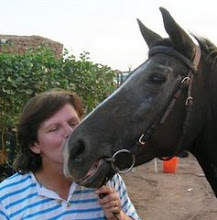 Hippotherapy is a unique treatment, which cannot be rivalled or reproduced by any other therapeutic method or piece of equipment. The horse becomes the tool that the therapist uses to improve the client’s neuromotor function. Once the client has accommodated to the movement of the horse, changes in gait, stride and pace, transitions to halt, corners and circles are introduced to further challenge the client and encourage alterations in balance and a need for reaction. Sitting backwards, side sitting or lying along the spine of a horse may also be used to achieve the desired outcome.
Hippotherapy is a unique treatment, which cannot be rivalled or reproduced by any other therapeutic method or piece of equipment. The horse becomes the tool that the therapist uses to improve the client’s neuromotor function. Once the client has accommodated to the movement of the horse, changes in gait, stride and pace, transitions to halt, corners and circles are introduced to further challenge the client and encourage alterations in balance and a need for reaction. Sitting backwards, side sitting or lying along the spine of a horse may also be used to achieve the desired outcome.Why the horse?
The horse demands movement!
The movement stimulates postural responses, ie it encourages one to sit up.
Sitting astride a horse increases the base area of support.
The rhythm of the horse at walk, especially on straight lines, affects muscle tone and helps to reduce muscle spasm.
The warmth of the horse, higher than that of a human, is very relaxing and helps to increase blood supply and release tight tissues.
Psychological Impact:
Exercise in the fresh air of a farm, away from hospitals, doctors office, therapy rooms, and home, help to promote a sense of well-being. Confidence is gained by mastering a skill normally performed by able-bodied people. The ability to control an animal much larger and stronger than oneself is a great confidence builder.
Educational impact (very important, as most disabled children in Sudan do not attend any sort of formal education).
Remedial Reading.
Before one can read, it is necessary to recognize the difference in shapes, sizes, and even colors. These can be taught more easily on horseback, as part of games and activities. There is less resistance to learning when it is part of a riding lesson. Through the use of signs placed around the arena, letters can be taught, and reading of individual words by word recognition can also be learned. Games involving signs for "exit", "danger", "stop" etc., help to teach important life skills involving reading.
Remedial Math.
Counting is learned by counting the horse's footsteps, objects around the arena, or even the horse's ears and legs. Number concepts are gained as the rider compares the number of legs on a horse to the number of his own legs. Addition and subtraction are taught through games involving throwing numbered foam dice and adding or subtracting the numbers. Because the concepts are taught through games, resistance to learning is decreased.


No comments:
Post a Comment